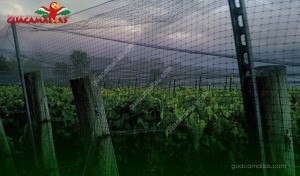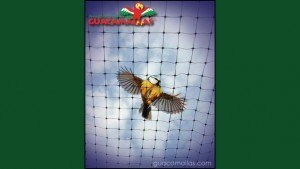Bird control net is the generic name for methods to eliminate or deter pests as birds from landing, roosting and nesting.
It is important to use professional bird control products that do not harm birds, other animals or people. DIY devices such as the glass shown above can injure the birds as well as any people that come in contact with it. When in doubt call a professional bird control installer.
Bird control net is important because pest birds can create health-related problems through their feces, including histoplasmosis, cryptococcosis, and psittacosis. Bird droppings may also cause damage to property and equipment. Birds also frequently steal from crops and fruit orchards.
Methods
Methods of bird control include physical deterrents, visual deterrents, sonic devices, trained birds of prey (falconry),[1] chemicals, contraceptives and active barriers, among others. Birds usually adapt quickly to most static bird control devices because the birds adapt after exposure to false threats. The avian control devices that are most effective either physically «block» the birds or «actively modify behavior» using a mild harmless shock.
Physical bird deterrents include such products as steel or plastic spike systems, bird netting, electrified wire systems, non-electrified wire systems, electrified track systems, slope barriers, mechanical spiders, chemical foggers and more. Sharp bird spikes can pierce and impale birds, while «blocking» and «shocking» methods do not harm birds. Unfortunately, blunt tip bird spikes may still impale birds on windy days. The safer shocking and blocking methods simply repel birds from an area with no harm. The Humane Society of the United States (HSUS) recommends the use of bird netting, bird wire, contraceptives and low-current electric barriers. Many different bird control products are used widely throughout the U.S. and the world with low current shocking wire and strips, netting, and mesh being the most effective bird control methods. Companies recommended by the Human Society that create these kinds of products include Bird Barrier America.[2]
Chemical deterrents range from products for turf to avicides. There are taste aversion products for geese, and fogging agents used for birds. Many localities have restrictions on the use of chemicals and pesticides targeted at birds if they intend to kill them. Chemical deterrents that do not harm birds are widely used with limited results.
Sonic avian deterrents are used widely in large open areas although effectiveness is low. Sounds are audible, and include predator and distress calls of a variety of birds to discourage pest birds from coming into an area. Common locations for these devices include vineyards, reclamation plants, airports, and other open areas. Sophisticated digital sound reproduction combined with random time off intervals, and random sequences are designed to prevent habituation by birds, and increase long-term effectiveness. Studies have shown most avian species will adapt and ignore such devices within months of initial contact.
Other static sound methods with limited effectiveness that birds may adapt quickly to include ultrasonic devices designed for enclosed or semi-enclosed areas. In theory, ultrasonic waves will annoy birds to stop them from entering and remaining in areas such as warehouses, parking garages, and loading docks. These products are not harmful to birds, yet it is debatable if the birds can hear these frequencies at loud enough decibel levels as bird are believed to have similar hearing to humans.[3] Thus, studies have shown effectiveness is very low within months of initial contact when using ultrasonic sound generators to prevent birds from habitating an area.
If just being placed in situ and left, audible bird scarers can easily become ineffective bird control solutions, however when managed on an on-going basis or used as part of a greater bird deterrent system, sound methods can deliver partial results for low level bird activity. Audible bird scarers are totally ineffective for nesting birds[4]
Wind driven scare devices include tapes, balloons, kites, and lightweight spinning turbines propelled by wind. These devices reflect sunlight and in limited uses scare birds that are new to an area. Typically, birds will quickly become acclimated to such devices as the birds learn the devices are not alive.
Normally, birds adapt within weeks of exposure to bird control devices that are not really alive or an actual threat to their survival, including sound devices, mechanical devices, wind blown scare devices, and partial perch modifications. In contrast, birds cannot adapt to total «blocking» methods or mild electrical low current «shocking» stimuli that modifies behavior. This is why bird control netting, mesh, tape and low current electrical barriers are tested to be the most effective avian control devices.
In 2013, Dr. John Swaddle and Dr. Mark Hinders at the College of William and Mary created a new method of deterring birds and other animals using benign sounds projected by conventional and directional (parametric) speakers.[5] The initial objectives of the technology were to displace problematic birds from airfields to reduce bird strike risks, minimize agricultural losses due to pest bird foraging, displace nuisance birds that cause extensive repair and chronic clean-up costs, and reduce bird mortality from flying into man-made structures. The sounds, referred to as a “Sonic Net,” do not have to be loud and are a combination of wave forms – collectively called «colored» noise – forming non-constructive and constructive interference with how birds and other animals such as deer talk to each other. Technically, the Sonic Nets technology is not a bird scarer, but discourages birds from flying into or spending time in the target area. The impact to the birds is similar to talking in a crowded room, and since they cannot understand each other they go somewhere else. Early tests at an aviary and initial field trials at a landfill and airfield indicate that the technology is effective and that birds do not habituate to the sound. The provisional and full patents were filed in 2013 and 2014 respectively, and further research and commercialization of the technology are ongoing.
http://ebook.worldlibrary.net/article/WHEBN0008871658/Bird%20control




